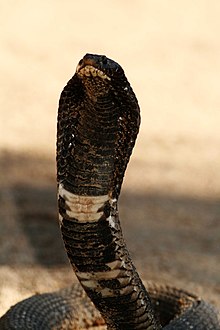Rinkhals
| Rinkhals | |
|---|---|
 |
|
| Scientific classification | |
| Kingdom: | Animalia |
| Phylum: | Chordata |
| Subphylum: | Vertebrata |
| Class: | Reptilia |
| Order: | Squamata |
| Suborder: | Serpentes |
| Family: | Elapidae |
| Genus: |
Hemachatus Fleming, 1822 |
| Species: | H. haemachatus |
| Binomial name | |
|
Hemachatus haemachatus (Bonnaterre, 1790) |
|
| Synonyms | |
The rinkhals (Hemachatus haemachatus), also called the ringhals or ring-necked spitting cobra, is a species of venomous elapid found in parts of southern Africa. It is not a true cobra in that it does not belong to the genus Naja, but instead belongs to the monotypic genus Hemachatus. It is closely related to the true cobras.
Coloration varies throughout its distribution area, but a characteristic of the species is the belly is dark with one or two light-coloured crossbands on the throat. Their average length is 90–110 cm. Some individuals may have a mostly black body, while others are striped. Rinkhals scales are distinct from those of true cobras in that they are ridged and keel-like.
This species is found in the Southern Cape province of South Africa, northeast through the Free State, Lesotho, Transkei, Kwazulu Natal, South Africa, Western Swaziland, Mpumalanga and parts of Gauteng, South Africa. An isolated population is centered on Inyanga on the Zimbabwe-Mozambique border.
The rinkhals has a varied diet. Its main prey is toads, but it also eats small mammals, amphibians, and other reptiles.
Rinkhals are unique amongst African cobras in being ovoviviparous. They give birth to 20–35 young, but as many as 65 young have been recorded.
...
Wikipedia

